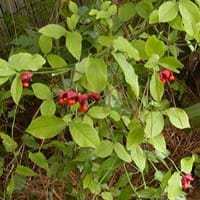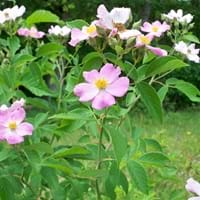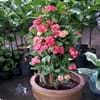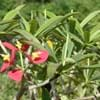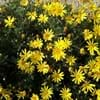Life Span
Perennial
Perennial
Type
Shrub
Flowering Plants, Ornamental Plant, Perennial, Shrubs
Origin
Northeastern United States, Mid-Atlantic United States, Southeastern United States, South-Central United States
Canada, Eastern North America
Types
Not Available
Not Available
Habitat
Shady Edge, Woodland Garden Dappled Shade
Wide range of ecological site
USDA Hardiness Zone
6-8
Not Available
AHS Heat Zone
9-1
Not Available
Sunset Zone
3b, 4, 5, 6, 7, 8, 9, 14, 15, 16, 17
Not Available
Habit
Upright/Erect
Clump-Forming
Flower Color
White, Ivory
Baby Pink
Flower Color Modifier
Not Available
Bicolor
Fruit Color
Magenta, Orange, Red
Non Fruiting Plant
Leaf Color in Spring
Green
Dark Green
Leaf Color in Summer
Green
Dark Green
Leaf Color in Fall
Yellow, Red, Burgundy
Dark Green
Leaf Color in Winter
Not Available
Light Green
Leaf Shape
Lance shaped
Pinnate
Plant Season
Fall, Winter
Spring, Summer, Fall
Sunlight
Full Sun, Partial Sun, Partial shade, Full Shade
Full Sun, Partial Sun
Growth Rate
Medium
Medium
Type of Soil
Clay, Loam
Loam, Sand
The pH of Soil
Acidic, Neutral
Acidic, Neutral
Soil Drainage
Well drained
Well drained
Bloom Time
Early Summer
Spring, Late Spring, Early Summer, Summer, Late Summer, Early Fall, Fall
Repeat Bloomer
No
Not Available
Tolerances
Drought
Drought
Where to Plant?
Ground, Pot
Container, Ground, Pot
How to Plant?
Seedlings, Semi-hardwood cuttings
Cuttings
Plant Maintenance
Medium
Medium
Watering Requirements
Average Water Needs, Do Not over Water
Average Water Needs
In Summer
Lots of watering
Lots of watering
In Spring
Moderate
Moderate
In Winter
Average Water
Average Water
Soil pH
Acidic, Neutral
Acidic, Neutral
Soil Type
Clay, Loam
Loam, Sand
Soil Drainage Capacity
Well drained
Well drained
Sun Exposure
Full Sun, Partial Sun, Partial shade, Full Shade
Full Sun, Partial Sun
Pruning
Remove damaged leaves, Remove dead branches, Remove dead leaves
Remove damaged leaves, Remove dead branches, Remove dead leaves
Fertilizers
All-Purpose Liquid Fertilizer
All-Purpose Liquid Fertilizer
Pests and Diseases
Red blotch
Beetles, Black Spot, Caterpillars, Downy mildew, Mosaic viruses, Powdery mildew, Rust, Scale insects, Thripes
Plant Tolerance
Drought
Drought
Flowers
Insignificant
Showy
Flower Petal Number
Single
Double
Edible Fruit
No
Not Available
Foliage Texture
Medium
Medium
Foliage Sheen
Matte
Glossy
Invasive
No
Not Available
Self-Sowing
No
Not Available
Attracts
Birds, Deers
Birds, Butterflies
Allergy
Diarrhea, poisonous if ingested
Rash
Aesthetic Uses
Not Used For Aesthetic Purpose
Showy Purposes
Beauty Benefits
Not Available
Not Available
Environmental Uses
Air purification
Air purification
Medicinal Uses
constipation, Liver problems, Malaria, Tonic
Not Available
Part of Plant Used
Bark, Root, Seeds
Flowers
Other Uses
The powdered bark is believed to eliminate dandruff, Used to make tea in cases of uterine prolapse, vomiting of blood
Oil is used in perfume, soaps, creams, etc.
Used As Indoor Plant
No
Yes
Used As Outdoor Plant
Yes
Yes
Garden Design
Mixed Border
Container, Cutflower, Feature Plant, Foundation, Mixed Border, Topiary / Bonsai / Espalier
Botanical Name
EUONYMUS americanus
Rosa carolina
Common Name
Strawberry bush, American strawberry bush, Bursting-heart
Carolina rose, pasture rose, low rose
In Hindi
Strawberry Bush
Carolina rose
In German
Strawberry Bush
Carolina stieg
In French
Strawberry Bush
Rosa carolina
In Spanish
Fresa Bush
Carolina se levantó
In Greek
φράουλα Μπους
Καρολίνα τριαντάφυλλο
In Portuguese
Morango de Bush
Carolina Rosa ou Pasture Rose
In Polish
Strawberry Bush
Karolina róży
In Latin
Classic Bush
Carolina resurrexit
Phylum
Magnoliophyta
Magnoliophyta
Class
Magnoliopsida
Magnoliopsida
Order
Celastrales
Rosales
Family
Celastraceae
Rosaceae
Clade
Angiosperms, Eudicots, Rosids
Not Available
Tribe
Not Available
Not Available
Subfamily
Celastroideae
Not Available
Number of Species
Not Available
Not Available
Season and Care of Strawberry Bush and Carolina Rose
Season and care of Strawberry Bush and Carolina Rose is important to know. While considering everything about Strawberry Bush and Carolina Rose Care, growing season is an essential factor. Strawberry Bush season is Fall and Winter and Carolina Rose season is Fall and Winter. The type of soil for Strawberry Bush is Clay, Loam and for Carolina Rose is Loam, Sand while the PH of soil for Strawberry Bush is Acidic, Neutral and for Carolina Rose is Acidic, Neutral.
Strawberry Bush and Carolina Rose Physical Information
Strawberry Bush and Carolina Rose physical information is very important for comparison. Strawberry Bush height is 90.00 cm and width 90.00 cm whereas Carolina Rose height is 90.00 cm and width 60.00 cm. The color specification of Strawberry Bush and Carolina Rose are as follows:
Strawberry Bush flower color: White and Ivory
Strawberry Bush leaf color: Green
Carolina Rose flower color: Baby Pink
- Carolina Rose leaf color: Dark Green
Care of Strawberry Bush and Carolina Rose
Care of Strawberry Bush and Carolina Rose include pruning, fertilizers, watering etc. Strawberry Bush pruning is done Remove damaged leaves, Remove dead branches and Remove dead leaves and Carolina Rose pruning is done Remove damaged leaves, Remove dead branches and Remove dead leaves. In summer Strawberry Bush needs Lots of watering and in winter, it needs Average Water. Whereas, in summer Carolina Rose needs Lots of watering and in winter, it needs Average Water.
